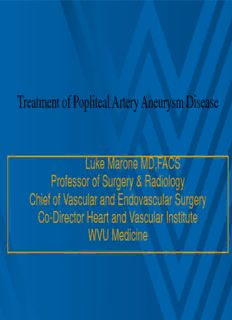
Treatment of Popliteal Artery Aneurysm Disease PDF
Preview Treatment of Popliteal Artery Aneurysm Disease
Treatment of Popliteal Artery Aneurysm Disease Luke Marone MD,FACS Professor of Surgery & Radiology Chief of Vascular and Endovascular Surgery Co-Director Heart and Vascular Institute WVU Medicine Disclosures None A More Relevant Disclosure • 70% of my current practice has become endovascular over the last decade Popliteal Aneurysm 70% of all peripheral aneurysms Incidence only 0.1% Repair indicated at >2 cm Clinical sequelae include Embolism 1. Thrombosis 2. Compressive symptoms 3. Rupture (rare) 4. Standard repair: surgical bypass Who Develops A Popliteal Aneurysm? • Tabular review of the existing literature through 2012 • 4247 patients were identified • 5459 limbs were treated • 96% males • Mean age 65 Tsilimparis et al. Ann Vasc Surg 2013;27:259-265 Comorbid Conditions Common to Popliteal Aneurysm Tsilimparis et al. Ann Vasc Surg 2013;27:259-265 How do these patients present? • The majority of patients are asymptomatic • 30% present with symptoms of claudication and moderate chronic ischemia • 17% present with acute limb ischemia requiring emergent repair • Majority have 2 to 3 vessel run off at the time of intervention The majority present for elective repair! Huang et al. J Vasc Surg 2014; on line 1-8. Ravn et al. J Vasc Surg 2007;46:236-43. The Endovascular Era An evolution toward endovascular (minimally invasive) intervention has occurred Why has this paradigm shift occurred? What is the “Gold Standard” for comparison? What outcomes are important for comparison? I am going to present an argument to support this shift Why has this shift occurred? Po tential benefits of endovasc ular repair • Lower rate of wound complications • Decreased functional disability • Reduced patient discomfort • Decreased need for general anesthesia • Shorter hospital length of stay What is the “Gold Standard” repair? • Medial approach (exclusion and bypass) • GSV, prosthetic, arm vein • Tunneled subcutaneous or anatomic • Target variability (BK pop, TP trunk or tibial) • Posterior approach • GSV,SSV or prosthetic There are no randomized trials comparing these diverse procedures
Description: